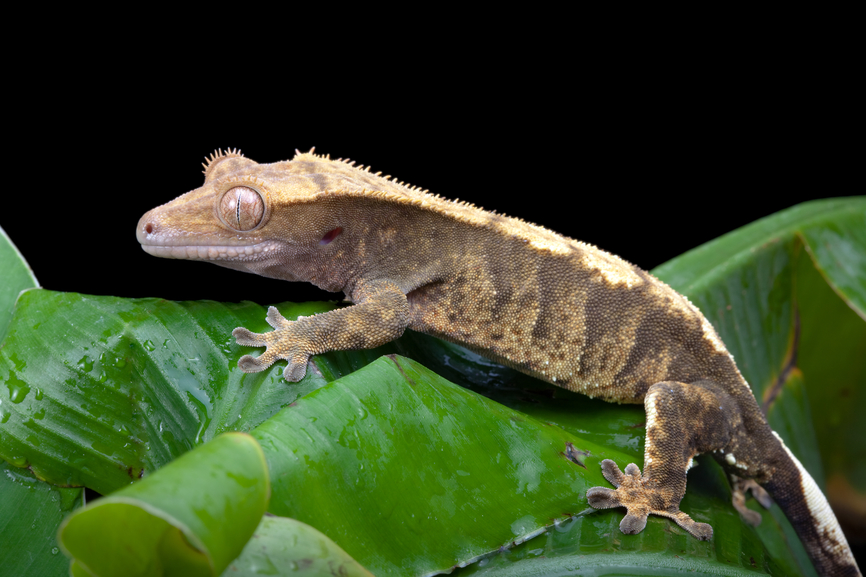Caring and Feeding For Your Crested Gecko
9th Jun 2015

For pet enthusiasts hoping to start enjoying the unique company and fun attitude of reptiles, crested geckos may be the perfect place to start. These small/medium sized lizards are great for beginner pet owners or veteran animal lovers wanting to house reptiles for the first time, as their needs are easy to meet compared to other, more finicky animals. With a few easy to master tips and a basic grasp of care practices, you can provide your crested gecko with the happy, healthy life that these beautiful lizards deserve.
But first, a little more about crested geckos, or Correlophus ciliatus. Originally native to New Caledonia, a chain of islands near Australia, the crested gecko was thought extinct until the early 1990’s, until it was rediscovered in the wild. Crested geckos have a slew of natural occurring colorations, but are most commonly grey, brown, yellow, or orange. One physical attribute that all crested geckos share in common is their “crests,” a set of hair like projections above their eyes that almost look like eyebrows and help give the crested gecko it’s unique head shape. If you are lucky enough to have a crested gecko as a pet, follow the pet owner tips below to keep them happy, healthy, and safe in your care.
Housing for Crested Geckos
In the wild, crested geckos are tree dwellers, preferring to spend their days in the rainforest canopies of their island homes. Because of these canopy tendencies, the bigger living space you can give your crested geckos, the better. However, crested geckos are fairly small sized lizards, reaching an average of around 8 inches tail and all. Which means that, if you don’t have the space or means to provide them with a nice big home to run around in, your gecko will be healthy in a smaller living area.
Baby geckos are happy in standard 10 gallon terrariums with screen tops. Just remember that, as tree dwellers, crested geckos are great jumpers, and might escape if you don’t leave your terrarium covered. As they reach maturity, your crested gecko will need a bigger home, and should moved into a 20 gallon terrarium at least. If you live in an area with moderate to high humidity levels, you can keep your gecko in a screen cage, which will provide better viewing opportunities and easy cleaning.
Decorations and Substrate for your Crested Gecko Terrarium
After you have the right sized tank for your crested gecko, it’s important to provide some suitable decorations for your lizard to play on, climb on, and hide under. Dried, cleaned tree branches inserted in a tank or cage at an angle will give your gecko a fun place to climb. And cork bark structures are great too, and will provide your gecko a safe place to sleep. A small plant can be a fun addition to your tank as well; try a Ficus benjamina for a safe and easy choice. Just don’t over decorate your tank. Make sure there is lots of open space, and your gecko’s living environment isn’t too cluttered.
In addition to decorations, your crested gecko terrarium will need a suitable substrate to keep your pet healthy. For new reptile owners, substrate is the material at the bottom of your gecko’s cage, usually formulated to mimic the natural rainforest floor of your lizard pet. Since your crested gecko will spend so much time climbing and off of the ground, you have a lot of substrate options to choose from. A basic reptile carpet is a good choice if you are worried about cleaning and maintenance. For a natural look that will go well with your wood decor, a peat moss blended soil mix will work well, as long as it doesn’t contain perlite.
One thing that you will want to be sure of when decorating your reptile terrarium is that all of the material you include is clean and safe for your lizard pet. Plants and tree branches found in the wild may not be the best choice, as they can contain insects, parasites, and dangerous microbes that can lead to health problems for your gecko. Start at your local pet store, and ask about their gecko decoration selections.
Temperature and Humidity Considerations for your Crested Gecko
Since crested geckos naturally live in a rainforest climate, you will have to pay some attention to the temperature and humidity levels in the home you create. For the happiest crested gecko, you want their terrarium to remain in the 78-82 degree Fahrenheit range during the day. Drops into the low 70s at night are fine, and your gecko will be ok if the temperature in their home reaches the 60s in winter. Mid to high 80s are fine for summer months as well, just make sure that your gecko is moved to a cool room if the temperature of their home gets close to 90.
To monitor these temperature requirements, pick up a suitable thermometer from your local pet shop. One thing to consider is that the higher temperature ranges within your terrarium should occur near branches, where your crested gecko will climb to simulate sunbathing. To provide heat for your gecko, a ceramic heating element is your best choice. Crested geckos are nocturnal, so a lamp may be disruptive, though if a heat lamp is your only option its most important to keep your cold blooded ectothermic friend warm. Make sure that heating elements are only placed on one side of your terrarium, soy our gecko can get away from the heat if they like.
As far as humidity considerations are concerned, your gecko will be happiest in a terrarium with relatively high humidity of between 50 and 70 percent. You can monitor these ranges with a device called a hygrometer, which can be picked up inexpensively at your local pet shop. In dry areas, you will probably have to take measures to make sure your gecko gets the humidity it needs. A light misting of their terrarium once a night is a good option. If you live in a very dry area, an in room humidifier can be used as well.. Just watch that hygrometer, and take steps to make sure the humidity stays in the 50-70 percent range.
Food and Water for Crested Geckos
Since crested geckos have become one of the most popular reptilian pet varieties in the world, it’s fairly easy to find the right food to keep them healthy. As omnivores, your crested geckos have specific nutritional requirements. Luckily, a widely available formula called “Crested Gecko Diet” by Repashy Superfoods will meet all of your geckos feeding needs in one easy package. Feed your gecko with this option three times a week by mixing this powder solution with two parts water in a shallow dish, leaving the food in your gecko’s terrarium for 24 hours.
If you want a particularly happy gecko, consider offering them live Dubia Roaches as a treat 1-2 times per week. Dubia Roaches can be bought from ABDragons.com and pet shops. As far as water goes, you will want to make sure that your gecko always has access to a water source in their terrarium. A small shallow dish is your best bet.
Handling your Crested Gecko
When you first pick up your crested gecko from the pet store, you will want to make sure that they have time to adapt to their new home before you handle them extensively. Give them at least 2-3 weeks in their new terrarium before you handle them for the first time. Doing so will help assure that your crested gecko has gotten over the shock of moving and settled into their new surroundings.
When you do start handling your crested gecko, keep initial handlings very short, in the one minute range. Your new pet will take some time to warm up to you, and prolonged handlings will stress your gecko. Once your gecko has gotten accustomed to being handled, you can safely handle them for five minutes or more. Just gradually build up your handling times, so your gecko can adapt to your company. In general, crested geckos are very fair tempered, but if you handle them for too long they will be sure to let you know they aren’t having a good time by nipping your hand. Gecko bites are mostly painless, but if you feel a nibble, put your gecko back in their cage right away.
Other Things to Consider
A last few important details: crested geckos live together well with other crested geckos, just as long as you don’t put two males in one terrarium. Crested geckos are known to shed their tails in order to outrun predators, and if yours does lose their tail it will not grow back. If you ever have any questions about your gecko, check in with your local pet shop. Since crested geckos are one of the most popular reptile pets in the world, it should be easy to troubleshoot any issues that come up. And by following the care guide above, you have all the basic knowledge you need to keep your gecko happy and healthy.


